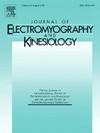Three-dimensional markerless pose estimation for anatomical landmarks of the shoulder and upper limb
IF 2.3
4区 医学
Q3 NEUROSCIENCES
引用次数: 0
Abstract
This study aimed to develop and validate a 3D markerless pose estimation algorithm for anatomical landmarks of the shoulder and upper limb. Twenty-six healthy participants were asked to hold 21 static positions, while both markerless and marker-based (applied after palpation) images were recorded using eight video cameras. A pre-trained convolutional neural network based on ResNet-50 was fine-tuned on 2612 markerless images to estimate the poses of 20 anatomical landmarks. The model was tested on 1 680 images by calculating the 3D Euclidean distances between predicted coordinates and those labeled from marker-based images. Across all positions, median and 90th percentile Euclidean distances were below 15 mm and 30 mm, respectively for all anatomical landmarks, except for the 8th thoracic vertebra, inferior angle of the scapula and medial epicondyle, which presented the highest Euclidean distances. For most of the anatomical landmarks, loss rates inferior to 6 % were observed for predicted coordinates. The neural network accuracy was similar between movements tested and not influenced by the degree of arm elevation. To conclude, a neural network was developed and validated for estimating shoulder and upper-limb anatomical landmarks poses, demonstrating promising accuracy for future clinical applications.
肩部和上肢解剖标志的三维无标记姿态估计
本研究旨在开发和验证一种用于肩部和上肢解剖标志的三维无标记姿态估计算法。26名健康参与者被要求保持21个静态姿势,同时使用8台摄像机记录无标记和基于标记(触诊后应用)的图像。基于ResNet-50的预训练卷积神经网络对2612张无标记图像进行微调,估计出20个解剖标志的姿态。通过计算预测坐标与基于标记的图像标记坐标之间的三维欧氏距离,在1680幅图像上对该模型进行了测试。在所有体位中,除第8胸椎、肩胛骨下角和内上髁的欧氏距离最大外,所有解剖标志的中位数和第90百分位欧氏距离分别小于15 mm和30 mm。对于大多数解剖标志,预测坐标的损失率低于6%。神经网络的准确性在测试的运动之间是相似的,并且不受手臂抬高程度的影响。综上所述,我们开发并验证了一个神经网络用于估计肩部和上肢解剖标志姿势,为未来的临床应用展示了良好的准确性。
本文章由计算机程序翻译,如有差异,请以英文原文为准。
求助全文
约1分钟内获得全文
求助全文
来源期刊
CiteScore
4.70
自引率
8.00%
发文量
70
审稿时长
74 days
期刊介绍:
Journal of Electromyography & Kinesiology is the primary source for outstanding original articles on the study of human movement from muscle contraction via its motor units and sensory system to integrated motion through mechanical and electrical detection techniques.
As the official publication of the International Society of Electrophysiology and Kinesiology, the journal is dedicated to publishing the best work in all areas of electromyography and kinesiology, including: control of movement, muscle fatigue, muscle and nerve properties, joint biomechanics and electrical stimulation. Applications in rehabilitation, sports & exercise, motion analysis, ergonomics, alternative & complimentary medicine, measures of human performance and technical articles on electromyographic signal processing are welcome.

 求助内容:
求助内容: 应助结果提醒方式:
应助结果提醒方式:


